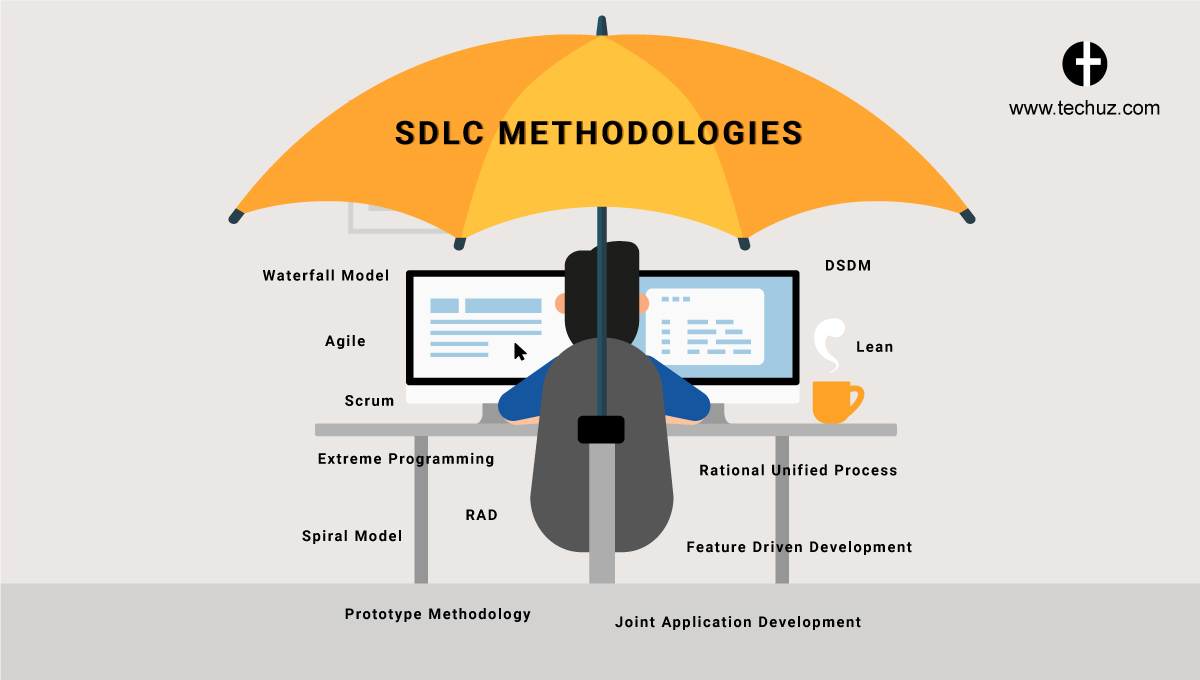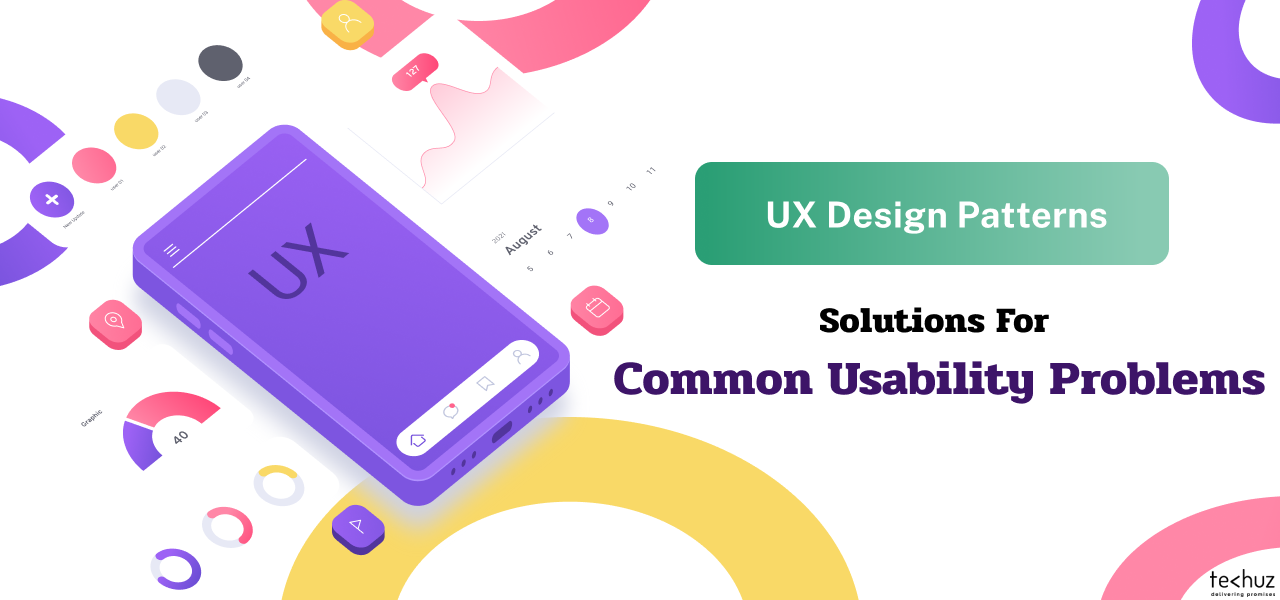Posted on
October 17, 2018
Updated on
March 26, 2024
Read time
 15 mins read
15 mins read
As a developer, you might spit out few fancy SDLC Methodologies that are at the top of your mind.
Or as a client, you may recall some sweet-sounding terms – “Agile’, “Lean’, “Dynamic System Development Model’ (alright, this one’s not so sweet) or ‘Spiral’, because the web development company you hired practices it or at least claims to practice it.
We all know that these SDLC methodologies are here for a while now and play a significant role in the success of your software or web application. They aim to provide the best quality product that meets or even transcends the client’s requirements.
But the fact is, apart from the ones that frequently make headlines, there is a huge list of SDLC models that you ought to know.
So in this blog, we have made a list of all those SDLC methodologies empowering you with the knowledge to apply them in your project. Here, take a look at the top SDLC methodologies with their pros and cons.
We answer all these questions and more in this blog:
- Top SDLC Methodologies
- 1. Waterfall Model
- 2. Rational Unified Process
- 3. Joint Application Development
- 4. Spiral Model
- 5. Prototype Methodology
- 6. Agile Software Development Methodology
- 7. Scrum Development Methodology
- 8. Extreme Programming Methodology
- 9. Feature Driven Development
- 10. Rapid Application Development
- 11. Dynamic System Development Model Methodology
- 12. Lean
- Waterfall
- Rational Unified Process
- Joint Application Development
- Spiral Model
- Prototype Methodology
- Agile Software Development Methodology
- Scrum Development Methodology
- Extreme Programming Methodology
- Feature Driven Development
- Rapid Application Development
- Dynamic System Development Model Methodology
- Â Lean
- Wrapping up
Top SDLC Methodologies
1. Waterfall Model
2. Rational Unified Process
3. Joint Application Development
4. Spiral Model
5. Prototype Methodology
6. Agile Software Development Methodology
7. Scrum Development Methodology
8. Extreme Programming Methodology
9. Feature Driven Development
10. Rapid Application Development
11. Dynamic System Development Model Methodology
12. Lean
Waterfall
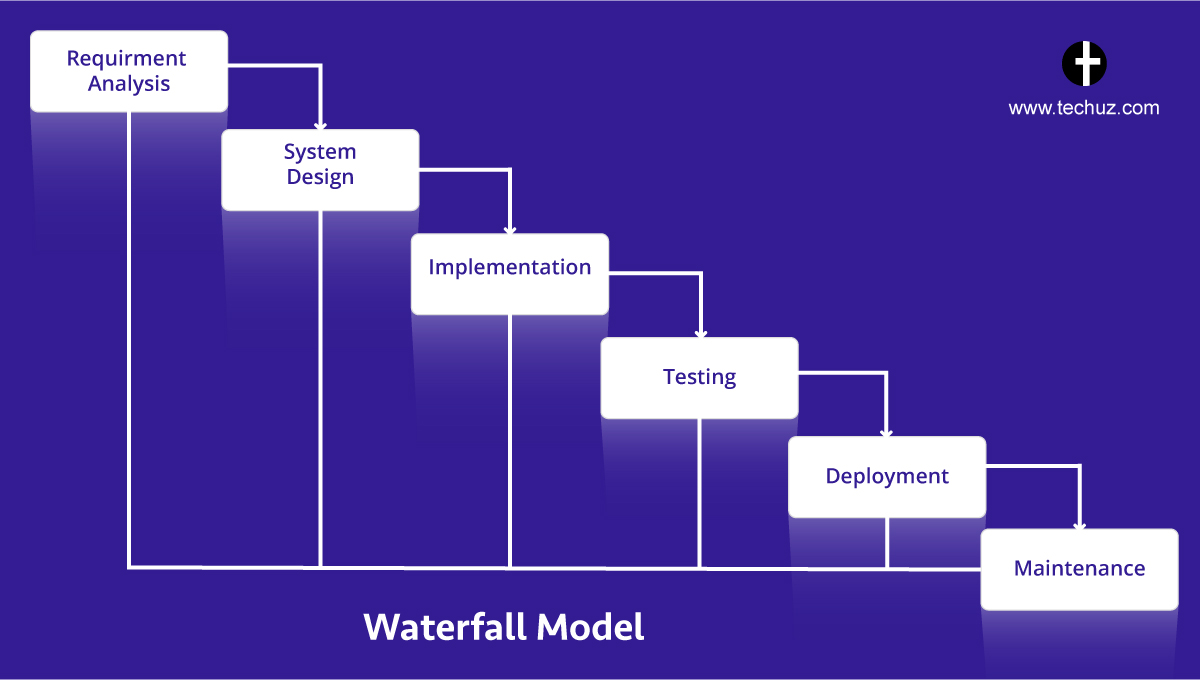
Waterfall Model is among the traditional SDLC methodologies. In fact, it is the oldest, most rigid and even easiest to understand. The idea here is quite simple: develop one phase of the project completely and move on to the next. Develop the new phase and advance to the next one. In this way, the project progresses and moves forward in a linear flow.
And as per the traditional waterfall model, any changes or modifications can’t be performed once a phase of the project is developed completely. This SDLC methodology is best fitted for small projects where deliverables can be defined clearly.
Pros
1. Waterfall model is easy to understand due to its simple linear structure
2. It helps to define the goals and deliverables at the early stage of the project
3. Project management is simple and effective as there are no unnecessary changes
4. This model works effectively with smaller projects where the requirements are clearly
5. Each stage are clearly defined and understood
Cons
1. Definitely not a great choice complex and long-term project
2. Impossible to make changes at the later stage
3. This SDLC model doesn’t work for maintenance type project
4. Successful execution of the project depends on precise requirements
5. No working model of the software until the end of the life cycle
Rational Unified Process
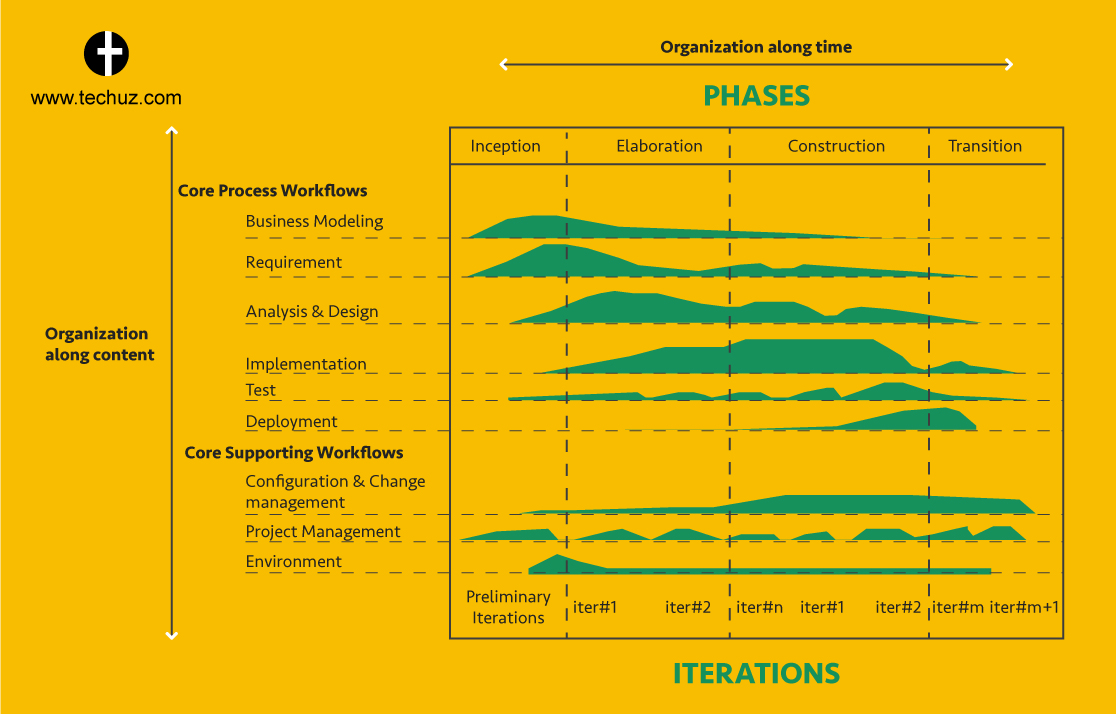
Introduced by Rational Software, a subsidiary of IBM, Rational Unified Process is one of the iterative SDLC methodologies
IBM defines RUP – “The Rational Unified Process® is a Software Engineering Process. It provides a disciplined approach to assigning tasks and responsibilities within a development organization. Its goal is to ensure the production of high-quality software that meets the needs of its end-users, within a predictable schedule and budget.”
RUP divides the development process into four different phases namely Inception, Elaboration, Construction and Transition. Each of these phases goes through nine different stages shown in the figure above.
By doing so it lays organized guidelines and structured templates to follow during the development process. Further, providing a specified plan at every phase helps in utilizing the available resources in an efficient and judiciously way.
Pros
1. This SDLC methodology puts emphasis on maintaining precise documentation
2. It reuses the components, thus saves the development time significantly
3. Ample amount of resources and literature is dispensed by its creators
4. The adaptive nature makes it easier to deal with changing customer needs and project requirements
Cons
1. For projects with new technology, the components can’t be reused and hence time spends on development can’t be saved
2. It is a relatively complex methodology which requires expert developers
3. Despite the unfathomable resources available, RUP is reasonably complicated model to understand
Joint Application Development
Joint Application Development was introduced in the early 70s as a software development methodology. However, due to its attribute to give more importance to business issues and solving them by involving the end user, instead of merely focusing on the technical aspects made it viable for any kind of projects.
This methodology works on a simple philosophy – involving the client and end-user in the development process results in a project that is more aligned and suitable to their needs.
Joint Application Development Model brings the developers, clients and other stakeholders together through a series of meetings and called JAD sessions. These collaborative workshops help to define the requirements more clearly and from different viewpoints of business, end-user as well as developers.
Pros
1. Identifies and lowers the risks through the collaboration of different parties
2. Requirements are well defined and clearly understood
3. Maintains continuous and proper communication between clients and developers
4. The open discussion with key members and customers also helps to diagnose any kind of errors at the initial stage. This results in quality and speedy development.
Cons
1. This method is significantly time-consuming
2. Discussions and opinions among team members can also work as a distraction towards goal
3. Considerable investment in planning and requirements can increase the total cost
Spiral Model
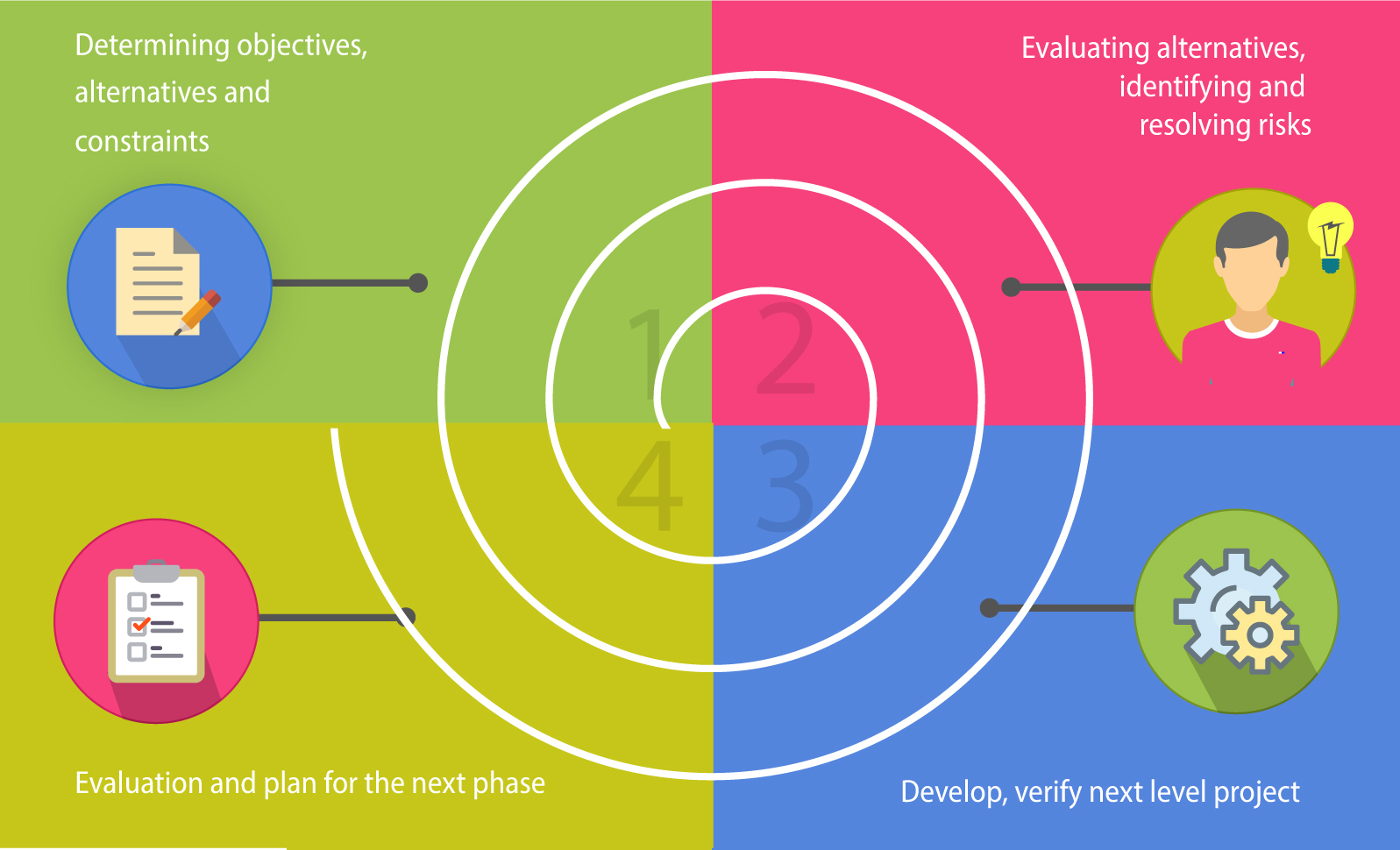
Spiral Model is considered to be one of the best Software Development Life Cycle methodologies for a large and complex project. It is an amalgamation of the two methodologies Waterfall Model and Prototyping Model.
If you look at its diagram, you can see that the spiral has different loops known as phases.
Each phase passes through four different quadrants (stages) and keeps on repeating until the final product is developed.
Each quadrant represents different tasks such as determination of requirement, analysing risks, engineering and planning. Thus, each phase of the project passes through. The success of this model largely depends on the risk-analysis, so a high level of risk-analysing expertise is required.
Pros
1. The spiral model is known for its flexibility as changes can be made on the later stage of the project
2. It is one the Software Development Life Cycle Methodologies that helps in mitigating the risk by analyzing and solving it beforehand
3. Clients are connected with the development team and project as they share the requirements and feedbacks of each phase
4. It is suitable for long-term and complex projects
Cons
1. Requires high risk-analysing expertise
2. The project takes a significantly long time to develop, increasing the overall expense of the project
3. It is complex to understand and implement
4. Since the number of iteration are unknown, the time required to complete the project remains a mystery
Prototype Methodology
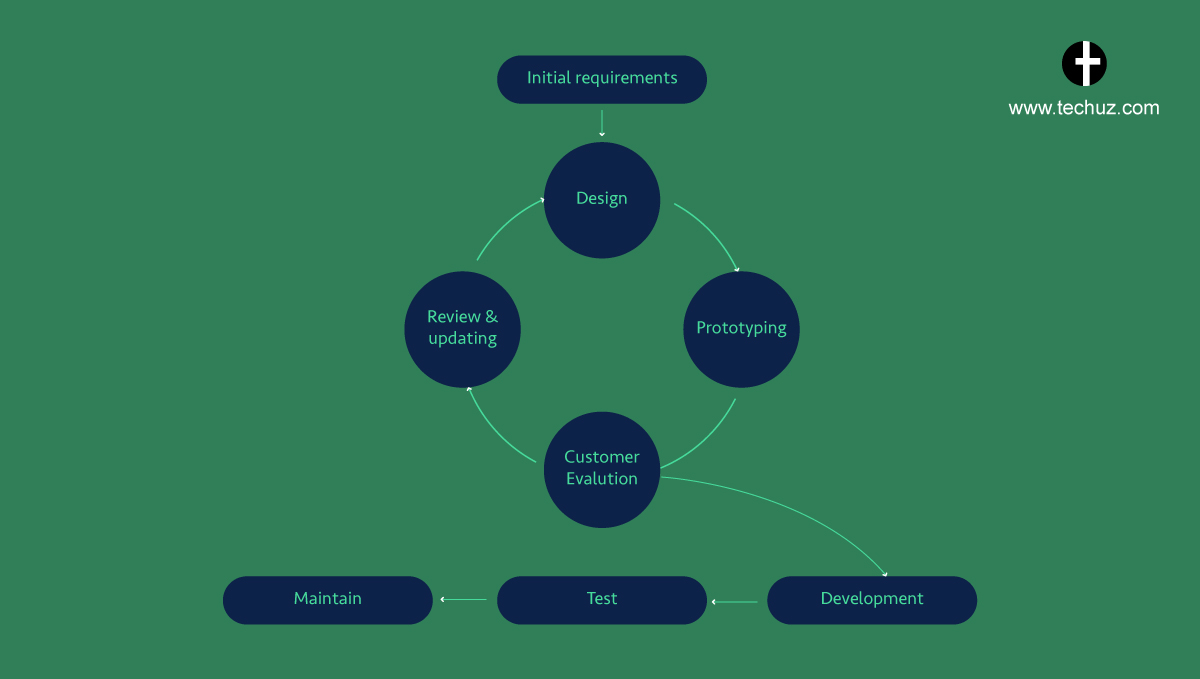
Prototyping model is one of the most used Software Development Life Cycle Methodologies. As per the name suggests, prototypes are created to visualize the functionality and components of the software.
In this methodology, a working prototype of the web application is created before initiating the actual development. These prototypes are sent to the customer for feedback and then necessary changes are made. This cycle of prototyping and updating as per customer’s feedback is repeated till the accurate prototype is achieved for the development.
Pros
1. During the entire cycle, the clients stay in the loop. Thus, transparency during the development is maintained
2. Prototyping Methodology is quite adaptive as any updates or new requirements are accommodated
3. It mitigates or eliminates the risks before the actual product is developed
4. One can expect quality results with this SDLC process as any flaws can be identified and refined before the development initiates
Cons
1. It can be comparatively costly as more time and resources are required for prototyping
2. Revisions and updates affect the project workflow and duration
Agile Software Development Methodology
Agile is among the modern breeds of Software Development Life Cycle Methodologies introduced to developing the utmost quality software. It was created in 2001 by 17 technologists with four main principles at its core:
#1. Individuals and interactions over processes and tools
#2. Working software over comprehensive documentation
#3. Customer collaboration over contract negotiation
#4. Responding to change over following a plan
Agile encourages building the project progressively rather than holistically. It follows the time-bound and iterative approach that builds software incrementally by updating and delivering small chunks instead of trying to deliver all at once. This incremental development is time-bound and the time period can be between a week to a month.
Pros
1. Highly adaptable to changes according to client and situation
2. Clients and customers are in direct communication providing transparency in the development process
3. Agile methodology mitigates the risks by updating the software with each iteration
Cons
1. No adequate documentation as the methodology deals with the functionality of the software
2. At times, it can go off track due to less focus on planning
Scrum Development Methodology
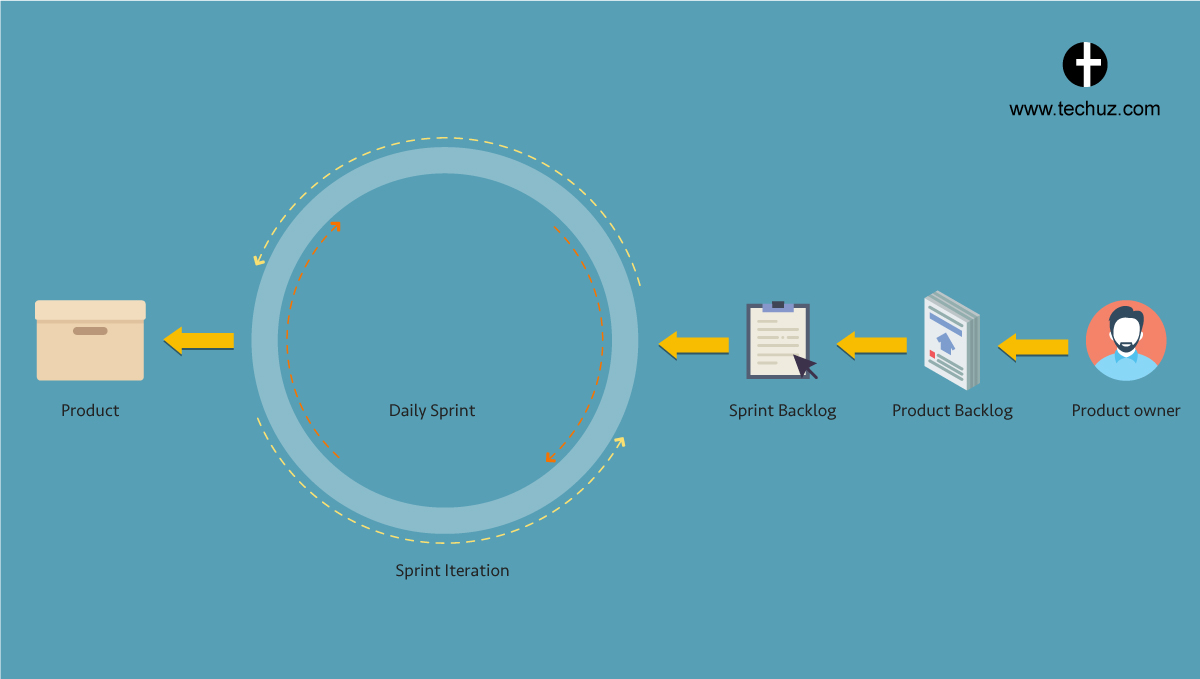
Scrum is another popular Agile SDLC framework widely used by the dev team. Usually people consider it as a methodology; however, Scrum is a framework that that uses Agile methodology for the project development.
The project is developed in series iterations and sprints which are time-bound between a week to a month. And its progress is gauged on daily basis.
(In Scrum, the term “sprint” is used for one development cycle generally known as iteration.)
Each sprint initiates with a meeting that plans the list of tasks to execute. i.e deliverables. Then the team starts working on the plan starting from ideation, coding, testing, integration and so on until the product is developed. And at the end of each day, a Scrum Meeting is held between the client, team and Scrum Master updating about the progress of daily tasks.
Pros
1. Time and money are judicially and effectively utilized
2. Projects are managed effectively by dividing it into sprints
3. Daily scrum meetings help clients to stay updated about the progress and the team stays focused
4. As a part of the Agile methodology, it is quite flexible to changes
5. Scrum works extremely well with small teams
Cons
1. Using scrum with a large team can be a daunting task
2. Highly experienced and dedicated team members are quintessential
3. Daily meetings and updates can sometimes get daunting
Extreme Programming Methodology
Extreme Programming Methodology accentuates on adaptability and customer satisfaction. The idea here is to adapt to the ever-changing requirements of the project during the life cycle rather than defining the requirements initially and resisting change at the later stage.
This SDLC Methodology has gained significant favours from varied software and web development companies, as it provides high customer satisfaction and enables the developers to execute the required modifications, making the product impeccable.
Apart from adaptability, the main goal of XP methodology is to lower the cost incurred during the changes, which are generally quite high in case of traditional methodologies. Even this methodology lives by a set of values and principles:
#1. Simplicity
#2. Streamlined Communication
#3. Feedback
#4. Respect
#5. Courage
Pros
1. Feedback from the client and flexibility to adapt the changes
2. Its core principles not only focuses on the client but also on employee satisfaction
3. The customer is constantly involved during the project and thus, can witness the progress
4. Focuses on reducing the cost of the project
Suggested read: How Much Does it Cost to Develop a Web Application?
Cons
1. Many experts consider it to be a code-centric methodology and less of design-centric
2. Requires a highly disciplined team and frequent client feedback
3. Frequent meetings are essential as there is less documentation of the requirements during the initial stage. This arises the need of team member to be present together and may not be effective remote teams
Suggested Read: Best Collaboration Tools to Effectively Manage a Remote Team
Feature Driven Development
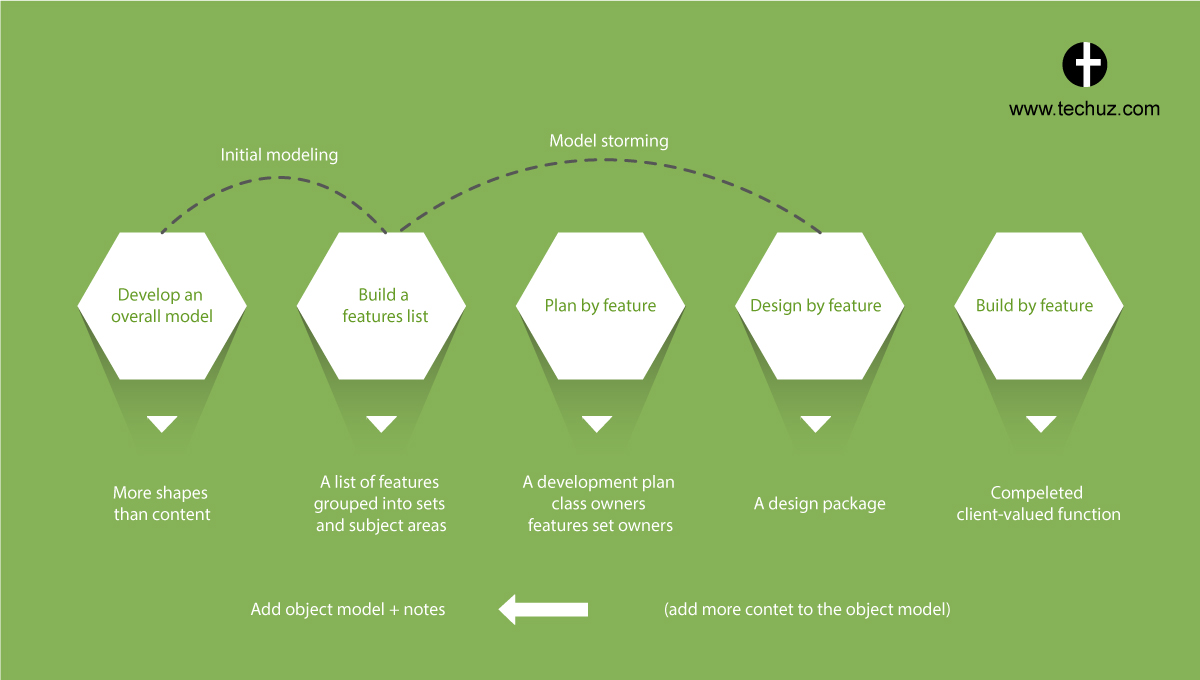
The agile process we discussed previously – Scrum and Extreme Programming work great with small teams of skilled people. However, when it comes to implementing with a large team, they are not an ideal choice.
The reason being – large teams face challenges such as effective communication, frequent meetings and updates, identifying and gauging the skills of the members and more.
Here, the Feature Driven Development or FDD comes into the picture as an SDLC methodology following Agile Manifesto that also works great with large teams.
As the name suggests, “Features” play an important role in Feature Driven Development. The project is divided into chunks as per its features and functionalities. And then planning, design, development and testing are in accordance with these features. Moreover, it also follows the iterative and incremental process.
Pros
1. Feature Driven Development makes it easier to develop a large project effectively
2. It also offers the client to gauge the progress easily
3. FDD is built on industry standards and follows the best practices for Software Development
4. Can employ different-teams simultaneously working on different features on the same project
Cons
1. It is built for larger projects and team. So, using this methodology for smaller projects is not suitable
2. The success is dependent on the leading developers; any kind of their inefficiency can lead to failure
3. Lack of proper written documents about the project and development
Rapid Application Development
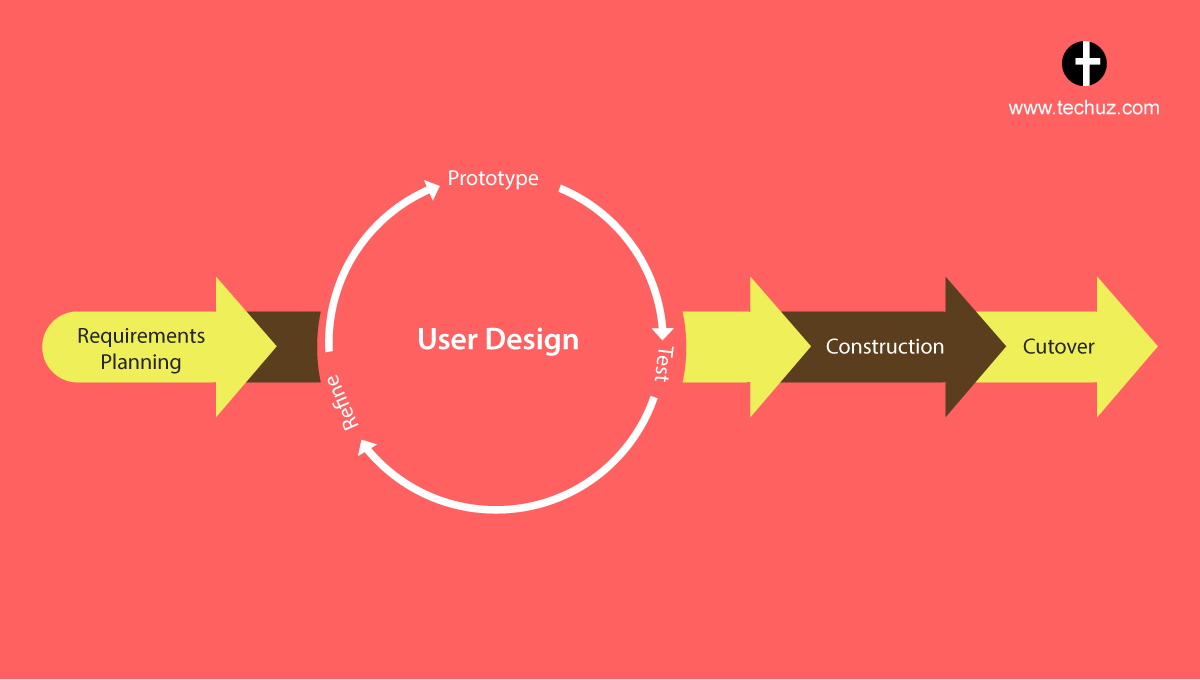
Rapid Application Development is an SDLC methodology to accelerate the development with rapid prototyping of the product.
It is an iterative model that focuses more on functional software and prototyping and less on planning.
There are four main phases of RAD namely, requirement planning, user design, construction and cutover. The first two being the most important as they go through several iterations until the product is fully refined as per the user requirements.
Pros
1. Tasks become easy and achievable by modularizing the project
2. The functional model of the product can be reviewed at an early stage
3. The user remains in the loop while the development and provides feedback
Cons
1. Requires highly skilled designers and developers with forte in the application area
2. Highly dependent on a strong team.
3. It would work best only with the systems and projects that can be divided into small chunks
4. RAD is highly expensive and is not recommended for small budget projects
Dynamic System Development Model Methodology
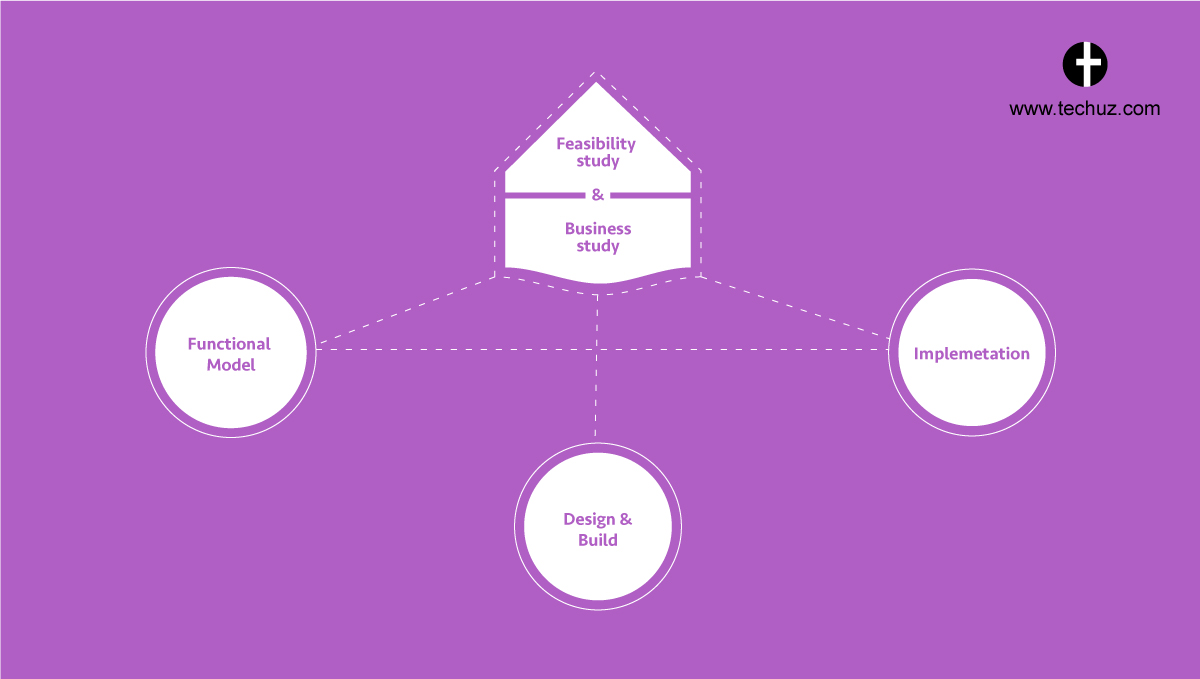
RAD methodology was quite swift but being unstructured it created chaos in development. This fueled the inception of a new Agile Methodology known as Dynamic Systems Development Model or feasible to say DSDM.
Developed by a group of project managers in 1994, DSDM is an iterative methodology that focuses on continuous user involvement along with developing it on budget and within the allotted time constraint.
It provides a framework for software development that passes through 4 phases. They are:
#1. Feasibility and business study
#2. Functional model / prototype iteration
#3. Design and build iteration
#4. Implementation
Pros
1. Adheres to budget and time of the project
2. Clients and end-users stay updated with the development
3. It is quite flexible to the changes
Cons
1. Just like RAD, it requires high technical as well as business expertise
2. It is of no use without proper user involvement
3. This methodology is uncommon making it hard to understand and implement
Lean
Lean shares quite a few similarities with Agile. In fact, lean is considered to be the model under the umbrella of Agile principles; although, it was coined way before the Agile Manifesto was introduced.
It is based on seven principles and values namely, eliminate waste, amplify learning, decide as late as possible, deliver as fast as possible, empower the team, build integrity in and see the whole.
At its core, the main aim of this SDLC methodology is to elevating the customer value and eliminating the wastage, i.e. the unproductive activities. This makes is a great choice for the projects with a tight budget.
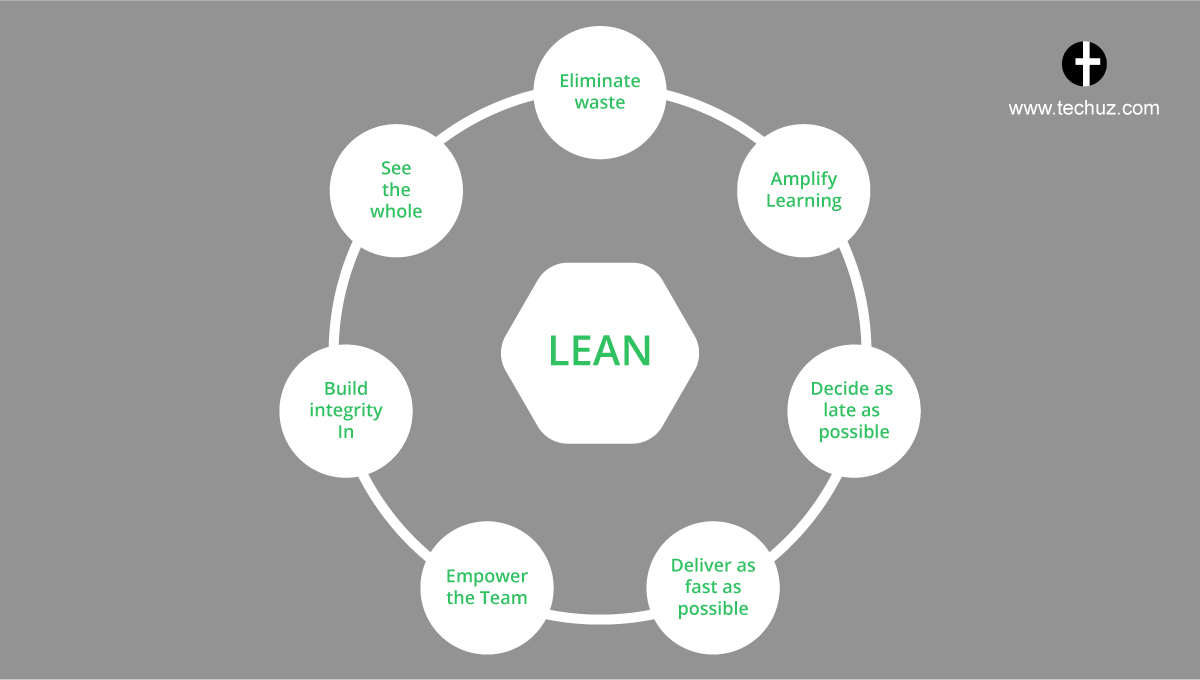
Pros
1. Saves time and money by eliminating wastage
2. Earlier product delivery to its value of “Deliver as fast as possible”
3. Lean can work great when the resources and time is scare
Cons
1. Requires proficient team that as the process is highly team-dependent
2. Decisions are to be made quickly during the process
3. There are chances that the team may get distracted due multi-tasking and varied responsibilities in small teams
Wrapping up
Now you know a dozen SDLC Methodologies. Each has a different use case, peculiar traits, forte and of course weakness. Some focusing on the process while other have end-user at their core. Some are conventional and rigid while some have evolved over time to serve as per the changing requirements. Choosing the right methodology according to the project needs and the product will definitely elevate the success rate of your project. Or if you are still unsure which SDLC methodology will work for you, feel free to contact us.
